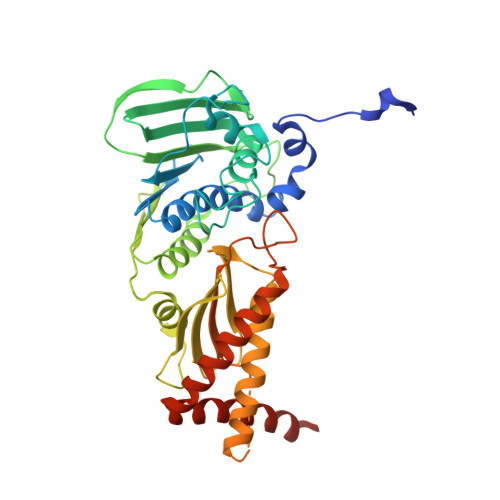Structure of the N-Terminal Gyrase B Fragment in Complex with ADPPi Reveals Rigid-Body Motion Induced by ATP Hydrolysis
Stanger, F.V., Dehio, C., Schirmer, T.(2014) PLoS One 9: e107289-e107289
- PubMed: 25202966
- DOI: https://doi.org/10.1371/journal.pone.0107289
- Primary Citation of Related Structures:
4PRV, 4PRX, 4PU9, 4R1F - PubMed Abstract:
Type II DNA topoisomerases are essential enzymes that catalyze topological rearrangement of double-stranded DNA using the free energy generated by ATP hydrolysis. Bacterial DNA gyrase is a prototype of this family and is composed of two subunits (GyrA, GyrB) that form a GyrA2GyrB2 heterotetramer. The N-terminal 43-kDa fragment of GyrB (GyrB43) from E. coli comprising the ATPase and the transducer domains has been studied extensively. The dimeric fragment is competent for ATP hydrolysis and its structure in complex with the substrate analog AMPPNP is known. Here, we have determined the remaining conformational states of the enzyme along the ATP hydrolysis reaction path by solving crystal structures of GyrB43 in complex with ADP⋅BeF3, ADP⋅Pi, and ADP. Upon hydrolysis, the enzyme undergoes an obligatory 12° domain rearrangement to accommodate the 1.5 Å increase in distance between the γ- and β-phosphate of the nucleotide within the sealed binding site at the domain interface. Conserved residues from the QTK loop of the transducer domain (also part of the domain interface) couple the small structural change within the binding site with the rigid body motion. The domain reorientation is reflected in a significant 7 Å increase in the separation of the two transducer domains of the dimer that would embrace one of the DNA segments in full-length gyrase. The observed conformational change is likely to be relevant for the allosteric coordination of ATP hydrolysis with DNA binding, cleavage/re-ligation and/or strand passage.
- Focal Area Structural Biology and Biophysics, Biozentrum, University of Basel, Basel, Switzerland; Focal Area Infection Biology, Biozentrum, University of Basel, Basel, Switzerland.
Organizational Affiliation:


















